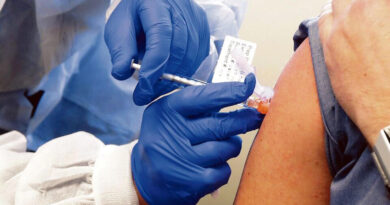Are Recent Reports of COVID Surges an Attempt to Suppress In-Person Voting?
Back in March, the COVID mantra was, “15 days to slow the spread”, meaning flattening the curve. The purpose was to avoid overwhelming the medical system as no one really knew what we were up against with the Wuhan virus.
This allowed time for the system to adapt and recalibrate to this new illness. As the virus peaked in mid-April, the subsequent months should have been the normal course of a viral pandemic, some getting sick to varying degrees, others unfortunately dying, but eventually reaching herd immunity, itself a longstanding concept — suddenly controversial.
This has been the course of past flu seasons and other viral pandemics, but none lead to shutting down economies all over the world, causing incalculable financial and social devastation to cities, states, countries, and individuals. Just when we see a light at the end of the tunnel there is a reported surge in cases, often timed to political events.
The first surge was in mid-summer, as businesses were opening and the presidential campaigns began in earnest with nominating conventions. President Trump’s rallies energized his base and are a unique feature to his campaign, something Sleepy Joe Biden could in no way replicate. Conveniently the surge put a damper on Trump rallies.
The second surge is now, just weeks before the 2020 presidential election. The Atlantic, one of many left-wing mouthpieces for the Democrat party, framed it politically, “The Coronavirus surge that will define the next four years.” How exactly does a viral illness define a future presidential term? Easily, if this has never been about the virus but instead about the election.
One only needs to look back to January 15, the same day, coincidentally or not, when the first case of the Chinese flu arrived in the US, the US and China signed a phase 1 trade deal, and the day that House Democrats waddled over to the Senate in solemn fashion carrying articles of impeachment against the President. A confluence of likely related events all on the very same day. Subsequent moves by Trump have been portrayed under a political microscope following on the heels of that January day.
What if the latest surge is just another political move, an attempt to influence election, now a week away?

YouTube screen grab
What exactly is this current surge? Is it a surge in positive tests, cases, hospitalizations, or deaths? A positive test alone is not a case, according to the CDC. The “case definition” of COVID is a positive test and symptoms. People who might have had a mild case a month ago may still have dead viral particles in their noses, triggering positive tests.
Over a million tests per day are performed in the US with acceptable positive rates of under 5 percent. That means 50,000 positive tests per day but most not infectious or symptomatic. More tests mean more positive results, what the media calls “cases.” If the US didn’t offer tests on demand as we do now, this so-called surge would go away. According to the New York Times,
The standard tests are diagnosing huge numbers of people who may be carrying relatively insignificant amounts of the virus.
Most of these people are not likely to be contagious and identifying them may contribute to bottlenecks that prevent those who are contagious from being found in time.
Conveniently, this current surge is in positive tests. Despite a rare moment of honesty and clarity from the New York Times, their current headline is, “US sets coronavirus case record amid new surge.” CNN is singing in harmony, “The US just reported its highest number of Covid-19 infections in one day since the pandemic’s start.”
No one speaks of false positive tests, likely inflating the test numbers. Remember how a goat and pawpaw fruit “tested positive” for COVID in Tanzania? How many of the current “cases” in the US are false positives?
What does this mean for the election? According to Gallup, Democrats by more than a two to one margin over Republicans, vote early, 62 to 28 percent. Republicans understandably distrust mail-in ballots given the daily reports of missing ballots and other electoral chicanery.
If voters planning on voting in person on Election Day can be scared or kept away, this favors Democrats as more of them have already voted early. Conveniently, this current surge may do just that.
The Atlantic offered a preview of this strategy back in June with this headline, “The looming threat to voting in person.” They worry that the Wuhan virus “needlessly jeopardizes the health of poll workers and voters” due to concerns over long lines, distancing, masks, hand sanitizer, and the older ages of poll workers. It’s funny that many of these same concerns are poo-pooed when it comes to BLM and Antifa protests.
NPR backed up the narrative this month asking, “Is casting a ballot in person a risk to your physical health?” Politico asked the same question, “Is it safe to vote in person?”
What a great way to scare voters, especially the elderly and vulnerable, from voting in person, targeting Republicans who are more likely to vote on election day. The electoral map provides another clue regarding this vote suppression strategy.
Where are these so-called COVID surges? The Chicago Tribune answers, “Coronavirus cases surge in key battleground states as election nears.” There is no concern for states like California and New York, which are a lock for Democrats. But instead, Iowa, Michigan, Minnesota, Pennsylvania, Ohio, and Wisconsin, all necessary for Trump to win on his way to reelection.
The pieces of the puzzle are coming together. Early mail in voting, pushed by and favoring Democrats, suppressing same day voting, disadvantages Republicans, particularly in the states Trump needs to carry. Election interference by voter suppression, brought to you by the Democrat media.
Don’t be surprised to see fear porn over in-person voting ratcheted up over the next, scaring voters into staying home, more Republican than Democrat voters. Nothing else is working for the Democrats and they are pulling out all the stops to pull rabbit out of the hat and salvage a losing candidate and campaign. Get out and vote, as if your life depends on it. Because it does.
Brian C Joondeph, MD, is a Denver based physician and freelance writer whose pieces have appeared in American Thinker, Daily Caller, Rasmussen Reports, and other publications. Follow him on Facebook, LinkedIn, Twitter, Parler, and QuodVerum
Back in March, the COVID mantra was, “15 days to slow the spread”, meaning flattening the curve. The purpose was to avoid overwhelming the medical system as no one really knew what we were up against with the Wuhan virus.
This allowed time for the system to adapt and recalibrate to this new illness. As the virus peaked in mid-April, the subsequent months should have been the normal course of a viral pandemic, some getting sick to varying degrees, others unfortunately dying, but eventually reaching herd immunity, itself a longstanding concept — suddenly controversial.
This has been the course of past flu seasons and other viral pandemics, but none lead to shutting down economies all over the world, causing incalculable financial and social devastation to cities, states, countries, and individuals. Just when we see a light at the end of the tunnel there is a reported surge in cases, often timed to political events.
The first surge was in mid-summer, as businesses were opening and the presidential campaigns began in earnest with nominating conventions. President Trump’s rallies energized his base and are a unique feature to his campaign, something Sleepy Joe Biden could in no way replicate. Conveniently the surge put a damper on Trump rallies.
The second surge is now, just weeks before the 2020 presidential election. The Atlantic, one of many left-wing mouthpieces for the Democrat party, framed it politically, “The Coronavirus surge that will define the next four years.” How exactly does a viral illness define a future presidential term? Easily, if this has never been about the virus but instead about the election.
One only needs to look back to January 15, the same day, coincidentally or not, when the first case of the Chinese flu arrived in the US, the US and China signed a phase 1 trade deal, and the day that House Democrats waddled over to the Senate in solemn fashion carrying articles of impeachment against the President. A confluence of likely related events all on the very same day. Subsequent moves by Trump have been portrayed under a political microscope following on the heels of that January day.
What if the latest surge is just another political move, an attempt to influence election, now a week away?

YouTube screen grab
What exactly is this current surge? Is it a surge in positive tests, cases, hospitalizations, or deaths? A positive test alone is not a case, according to the CDC. The “case definition” of COVID is a positive test and symptoms. People who might have had a mild case a month ago may still have dead viral particles in their noses, triggering positive tests.
Over a million tests per day are performed in the US with acceptable positive rates of under 5 percent. That means 50,000 positive tests per day but most not infectious or symptomatic. More tests mean more positive results, what the media calls “cases.” If the US didn’t offer tests on demand as we do now, this so-called surge would go away. According to the New York Times,
The standard tests are diagnosing huge numbers of people who may be carrying relatively insignificant amounts of the virus.
Most of these people are not likely to be contagious and identifying them may contribute to bottlenecks that prevent those who are contagious from being found in time.
Conveniently, this current surge is in positive tests. Despite a rare moment of honesty and clarity from the New York Times, their current headline is, “US sets coronavirus case record amid new surge.” CNN is singing in harmony, “The US just reported its highest number of Covid-19 infections in one day since the pandemic’s start.”
No one speaks of false positive tests, likely inflating the test numbers. Remember how a goat and pawpaw fruit “tested positive” for COVID in Tanzania? How many of the current “cases” in the US are false positives?
What does this mean for the election? According to Gallup, Democrats by more than a two to one margin over Republicans, vote early, 62 to 28 percent. Republicans understandably distrust mail-in ballots given the daily reports of missing ballots and other electoral chicanery.
If voters planning on voting in person on Election Day can be scared or kept away, this favors Democrats as more of them have already voted early. Conveniently, this current surge may do just that.
The Atlantic offered a preview of this strategy back in June with this headline, “The looming threat to voting in person.” They worry that the Wuhan virus “needlessly jeopardizes the health of poll workers and voters” due to concerns over long lines, distancing, masks, hand sanitizer, and the older ages of poll workers. It’s funny that many of these same concerns are poo-pooed when it comes to BLM and Antifa protests.
NPR backed up the narrative this month asking, “Is casting a ballot in person a risk to your physical health?” Politico asked the same question, “Is it safe to vote in person?”
What a great way to scare voters, especially the elderly and vulnerable, from voting in person, targeting Republicans who are more likely to vote on election day. The electoral map provides another clue regarding this vote suppression strategy.
Where are these so-called COVID surges? The Chicago Tribune answers, “Coronavirus cases surge in key battleground states as election nears.” There is no concern for states like California and New York, which are a lock for Democrats. But instead, Iowa, Michigan, Minnesota, Pennsylvania, Ohio, and Wisconsin, all necessary for Trump to win on his way to reelection.
The pieces of the puzzle are coming together. Early mail in voting, pushed by and favoring Democrats, suppressing same day voting, disadvantages Republicans, particularly in the states Trump needs to carry. Election interference by voter suppression, brought to you by the Democrat media.
Don’t be surprised to see fear porn over in-person voting ratcheted up over the next, scaring voters into staying home, more Republican than Democrat voters. Nothing else is working for the Democrats and they are pulling out all the stops to pull rabbit out of the hat and salvage a losing candidate and campaign. Get out and vote, as if your life depends on it. Because it does.
Brian C Joondeph, MD, is a Denver based physician and freelance writer whose pieces have appeared in American Thinker, Daily Caller, Rasmussen Reports, and other publications. Follow him on Facebook, LinkedIn, Twitter, Parler, and QuodVerum
*** This article has been archived for your research. The original version from American Thinker can be found here ***


